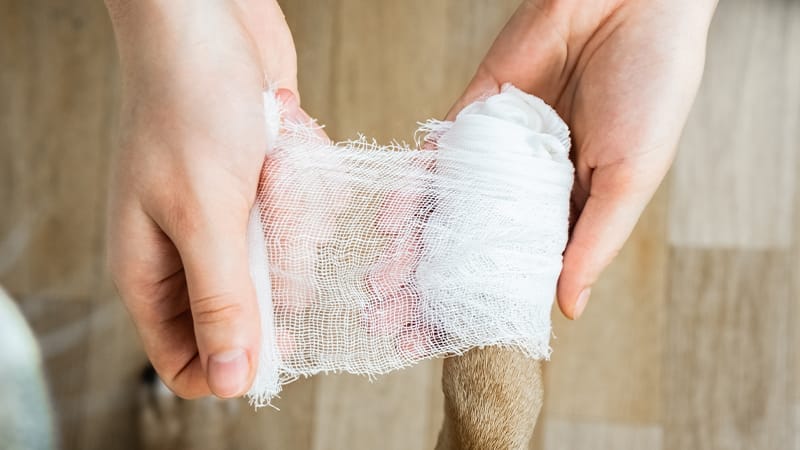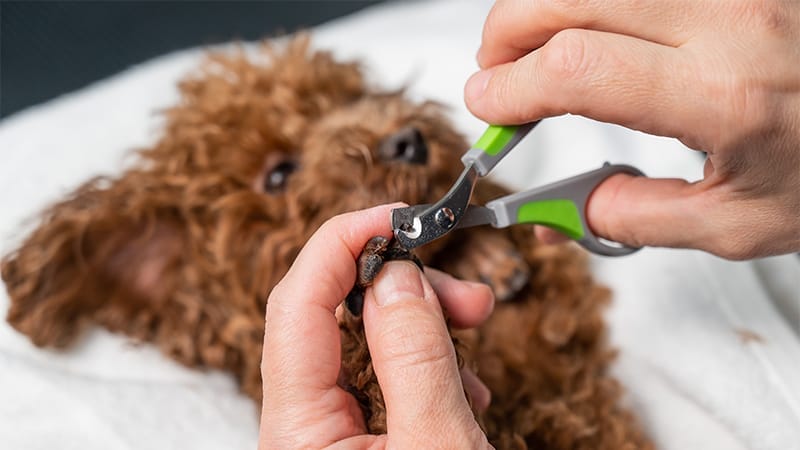
If your dog suddenly yelps in pain when putting weight on a paw and starts limping, the culprit may be a broken, cracked, split, or injured nail. Nail injuries can be incredibly painful for your furry friend, and they can occur for a variety of reasons. While some injuries may be minor, others can be more serious, leading to bleeding, pain, and the risk of infection. In such cases, it is crucial to seek care promptly with your family veterinarian or a veterinary urgent care or emergency hospital, such as MedVet.
Read on to learn the common causes of nail injuries in dogs, signs to look out for, what to do if your dog breaks a nail, how you can help prevent nail injuries, and when you should seek veterinary care.
Common Causes of Broken Nails in Dogs
A bleeding or broken toenail is a common injury in dogs. Dogs break their nails for a variety of reasons, including:
- Getting a nail “caught” in a door or fence or snagging it on the carpet
- Excessive scratching or digging
- Playing on rough surfaces or during vigorous activities
- Landing on their paws in a way that bends or breaks the nail
- Age as nails can become dry and brittle the older a dog gets
There are also medical reasons that may cause your dog’s nail to be more susceptible to injury, such as:
- Bacterial infections: Just as bacterial infections can affect your dog’s skin, they can affect your dog’s nails. Conditions that can cause bacterial infections in your dog’s nail beds include environmental allergies and food allergies.
- Fungal infections: A fungal infection in the nail (onychomycosis) can cause your dog’s nail to be brittle and more likely to split, crack, or tear.
- Lupoid onychodystrophy: While rare, this inflammatory disease causes abnormal nail formations in dogs, which can lead to nail injuries. Any breed can develop lupoid onychodystrophy but breeds more likely to have the condition include German Shepherd, Rottweiler, Labrador Retriever, Gordon Setter, Cavalier King Charles Spaniel, Schipperke, Welsh Corgi, West Highland White Terrier, Bearded Collie, Miniature and Giant Schnauzer, Akita, Greyhound, and German Short Hair Pointer.
What Can Happen if My Dog Breaks a Nail?
Dog nails have a collection of blood vessels in them that are called the quick. The quick is a living tissue that is covered by a hard layer, called keratin, that protects it. If a dog’s nail is trimmed too short or becomes cracked or broken, that quick may get exposed and can become painful. The quick is also attached to the bone, so any damage to it can lead to infection. In addition to infection, a broken toenail left untreated can cause blood loss and pain for your pet.
Dogs may attempt to chew off a broken nail due to discomfort or irritation. However, this can worsen the injury and potentially lead to infection. It’s crucial to prevent your dog from chewing or licking the affected area to minimize the risk of further damage.
What Should I Do if My Dog Breaks a Nail?
If your dog has a broken nail, follow these steps:
- Safely restrain your dog and then control the bleeding by gently wrapping the foot in gauze or a towel. Exercise caution when wrapping the paw to avoid wrapping it too tightly, as this can result in swelling. If the bleeding does not stop within 10 minutes, apply a cauterizing powder or styptic pencil to the nail (you can also use flour or cornstarch). If the bleeding continues, take your pet immediately to your family veterinarian or an urgent care or emergency room like MedVet.
- If there is a loose piece of nail that may snag and cause further damage, gently remove it with sharp trimmers. Once the bleeding has stopped, gently clean the nail with warm water and apply a clean gauze bandage to your pet’s foot.
- Contact your family veterinarian who may want to see your pet within 12 to 24 hours. Your dog may be given antibiotics to help prevent nail bed infection or pain medication to make them more comfortable.

How Can I Help Prevent Nail Tears?
The most important thing you can do at home to protect your dog’s nail health is grooming, including regular nail maintenance to minimize the likelihood of torn nails. The most effective way to help your dog avoid nail tears is to keep their nails trimmed. Short nails are less likely to become broken than long ones. Keeping your dog’s dewclaws properly trimmed is particularly important. Unlike the other nails that touch the ground, dewclaws are located higher up on the inner part of their foot. Most dogs have four nails on each rear foot and five on their front feet, with the dewclaw being an additional nail on the inner side.
Your family veterinarian can show you the proper way to trim your dog’s nails at home. Using the proper tools is essential – always use sharp nail trimmers to avoid shredding the nail which can increase the likelihood of a break. Trim the nail as short as possible while avoiding the quick. Dark nails can be more challenging than white nails where the pinkish quick can be more easily seen. If you’re not comfortable trimming your dog’s nails yourself, your family veterinarian or a professional groomer can do it for you.
If your dog likes scratching or digging, consider providing suitable scratching surfaces, like scratching posts or pads, and encourage them to use that to avoid stress on their nails. When your dog is outdoors on rough surfaces, dog booties or paw balms applied to their feet can help shield their nails from potential damage.

When to Consult a Veterinarian About a Dog Nail Injury
A torn or broken nail in dogs may seem like a minor issue, but it can cause significant discomfort and potential complications if left untreated. While some minor injuries may heal on their own, it’s essential to seek veterinary care for proper diagnosis and treatment, especially if your dog’s nail is cracked, continually painful, bleeding, or the quick is exposed. If you notice any signs of infection, such as redness, swelling, or discharge or your dog has difficulty walking or is limping, visit your family veterinarian or find a MedVet location near you. By taking preventive measures and promptly addressing nail injuries, you can ensure your dog’s comfort and well–being. Remember, your family veterinarian is the best resource for guidance and support when it comes to your dog’s nail health.